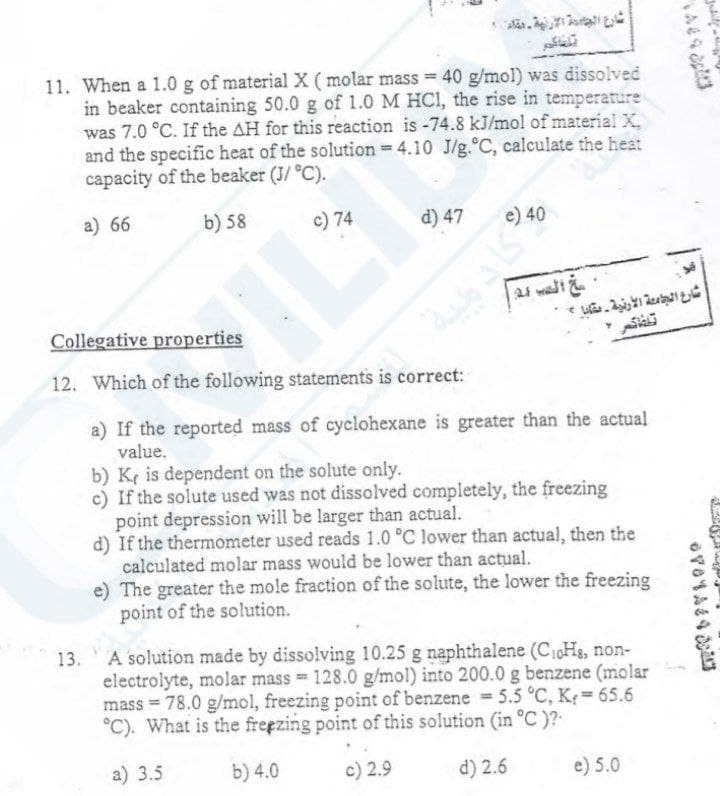13. A solution made by dissolving 10.25 g naphthalene (C₁oHs, non- electrolyte, molar mass= 128.0 g/mol) into 200.0 g benzene (molar mass=78.0 g/mol, freezing point of benzene = 5.5 °C, K = 65.6 °C). What is the freezing point of this solution (in °C )?- a) 3.5 b) 4.0 c) 2.9 d) 2.6 e) 5.0
13. A solution made by dissolving 10.25 g naphthalene (C₁oHs, non- electrolyte, molar mass= 128.0 g/mol) into 200.0 g benzene (molar mass=78.0 g/mol, freezing point of benzene = 5.5 °C, K = 65.6 °C). What is the freezing point of this solution (in °C )?- a) 3.5 b) 4.0 c) 2.9 d) 2.6 e) 5.0
General Chemistry - Standalone book (MindTap Course List)
11th Edition
ISBN:9781305580343
Author:Steven D. Gammon, Ebbing, Darrell Ebbing, Steven D., Darrell; Gammon, Darrell Ebbing; Steven D. Gammon, Darrell D.; Gammon, Ebbing; Steven D. Gammon; Darrell
Publisher:Steven D. Gammon, Ebbing, Darrell Ebbing, Steven D., Darrell; Gammon, Darrell Ebbing; Steven D. Gammon, Darrell D.; Gammon, Ebbing; Steven D. Gammon; Darrell
Chapter6: Thermochemisty
Section: Chapter Questions
Problem 6.109QP: A 21.3-mL sample of 0.977 M NaOH is mixed with 29.5 mL of 0.918 M HCl in a coffee-cup calorimeter...
Related questions
Question
please solve quesssssstion 13

Transcribed Image Text:11. When a 1.0 g of material X ( molar mass = 40 g/mol) was dissolved
in beaker containing 50.0 g of 1.0 M HCl, the rise in temperature
was 7.0 °C. If the AH for this reaction is -74.8 kJ/mol of material X.
and the specific heat of the solution = 4.10 J/g.°C, calculate the heat
capacity of the beaker (J/ °C).
a) 66
b) 58
c) 74
d) 47
e) 40
مج الدب 24:
الجمعة
شارع الجامعة الأرنية ـ مقايا -
Skj
Collegative properties
12. Which of the following statements is correct:
a) If the reported mass of cyclohexane is greater than the actual
value.
b) K, is dependent on the solute only.
c) If the solute used was not dissolved completely, the freezing
point depression will be larger than actual.
d) If the thermometer used reads 1.0 °C lower than actual, then the
calculated molar mass would be lower than actual.
e) The greater the mole fraction of the solute, the lower the freezing
point of the solution.
A solution made by dissolving 10.25 g naphthalene (C₁0Hs, non-
electrolyte, molar mass= 128.0 g/mol) into 200.0 g benzene (molar
mass = 78.0 g/mol, freezing point of benzene = 5.5 °C, K = 65.6
°C). What is the freezing point of this solution (in °C)?:
a) 3.5
b) 4.0
c) 2.9
d) 2.6
e) 5.0
14443
67844443
Expert Solution
This question has been solved!
Explore an expertly crafted, step-by-step solution for a thorough understanding of key concepts.
Step by step
Solved in 2 steps

Knowledge Booster
Learn more about
Need a deep-dive on the concept behind this application? Look no further. Learn more about this topic, chemistry and related others by exploring similar questions and additional content below.Recommended textbooks for you

General Chemistry - Standalone book (MindTap Cour…
Chemistry
ISBN:
9781305580343
Author:
Steven D. Gammon, Ebbing, Darrell Ebbing, Steven D., Darrell; Gammon, Darrell Ebbing; Steven D. Gammon, Darrell D.; Gammon, Ebbing; Steven D. Gammon; Darrell
Publisher:
Cengage Learning

Chemistry: Principles and Reactions
Chemistry
ISBN:
9781305079373
Author:
William L. Masterton, Cecile N. Hurley
Publisher:
Cengage Learning

Principles of Modern Chemistry
Chemistry
ISBN:
9781305079113
Author:
David W. Oxtoby, H. Pat Gillis, Laurie J. Butler
Publisher:
Cengage Learning

General Chemistry - Standalone book (MindTap Cour…
Chemistry
ISBN:
9781305580343
Author:
Steven D. Gammon, Ebbing, Darrell Ebbing, Steven D., Darrell; Gammon, Darrell Ebbing; Steven D. Gammon, Darrell D.; Gammon, Ebbing; Steven D. Gammon; Darrell
Publisher:
Cengage Learning

Chemistry: Principles and Reactions
Chemistry
ISBN:
9781305079373
Author:
William L. Masterton, Cecile N. Hurley
Publisher:
Cengage Learning

Principles of Modern Chemistry
Chemistry
ISBN:
9781305079113
Author:
David W. Oxtoby, H. Pat Gillis, Laurie J. Butler
Publisher:
Cengage Learning

Chemistry
Chemistry
ISBN:
9781305957404
Author:
Steven S. Zumdahl, Susan A. Zumdahl, Donald J. DeCoste
Publisher:
Cengage Learning


Chemistry: An Atoms First Approach
Chemistry
ISBN:
9781305079243
Author:
Steven S. Zumdahl, Susan A. Zumdahl
Publisher:
Cengage Learning